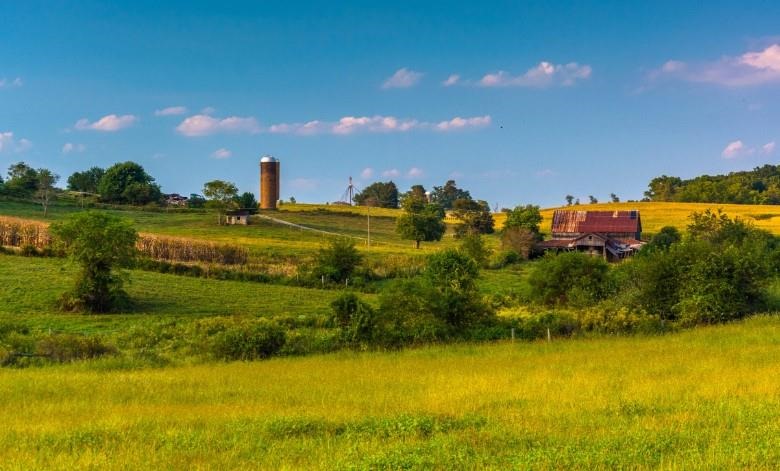By Hannah Ziegler
Maryland agriculture officials, conservation groups and producers from the state’s more than 12,000 farms are vying for their priorities to appear in this year’s federal farm bill.

A view of rolling hills in rural Howard County.
A behemoth package of legislation considered to be the primary vehicle for addressing agriculture issues and setting policy, the five-year farm bill expires in September.
The bill authorizes billions of dollars in a dozen areas ranging from crop price supports to forestry, with most funding set aside for nutrition programs.
This year, groups in Maryland will push to increase farm bill programs for smaller specialty farms – which produce crops like fruits, vegetables and tree nuts – and establish more incentives for farmers to embrace conservation practices.
Agriculture is Maryland’s biggest industry, but the state’s farms occupy an average of 161 acres, according to the Maryland Department of Agriculture. That means most Maryland farms are considered small or medium within farm bill programs, which disproportionately subsidize large farms growing commodity crops like corn, wheat and soybeans.
“The pie always gets sliced too small for farms like us, and the pie is sliced much bigger to the really corporate, big industrial farms,” said David Paulk, an organic vegetable farmer who sells at Sassafras Creek Farm in Leonardtown. “That’s where the farm bill needs to be opened up and restructured to be more inclusive.”
Crop insurance – purchased by farmers to protect against the loss of their crops or falling prices – is among the most important provisions of the farm bill, with roughly $90 billion authorized in 2018. But insurance protection remains out of reach for most Maryland specialty crop farmers.
“Crop insurance has worked very well for the major row crop industry, but it’s been lacking when it comes to specialty crops. Crop insurance isn’t available or the cost of the insurance isn’t in line with the coverage provided,” said Patt Wolffe, senior national affairs director for the Maryland Farm Bureau.
The farm bill has slowly expanded the number of crops covered by crop insurance in the last few decades, said James MacDonald, a research professor at the University of Maryland agriculture school.
This year could be a tipping point for expanding this safety net beyond the largest agricultural commodities, MacDonald said.
Incentivizing farm bill conservation programs is also a key priority this year as Maryland fights to preserve the Chesapeake Bay watershed.
Roughly 90 percent of remaining reductions in Chesapeake Bay pollution need to come from state agricultural sectors, said Beth McGee, the science and agricultural policy director at the Chesapeake Bay Foundation.
Maryland is already a national leader in climate-friendly farm practices. The state has heavily promoted sustainable agriculture and boasts one of the highest rates of cover cropping, plants grown primarily to benefit the successful growth of other future crops by preventing soil erosion and controlling pests and weeds. But conservationists like McGee hope to see incentives in this farm bill for greater crop diversity in the state.
“From the global perspective, the current programs are subsidizing a food system that isn’t sustainable. And we need to start making incentives for smaller farms that want to diversify,” McGee said.
The pandemic exposed the need for more diverse agricultural practices across the United States, said Marc Grossman with The Farm at Our House in Olney. Provisions in the new farm bill should be more environmentally “targeted” and “resilient” because current regulation in the U.S. agricultural industry discourages farmers from implementing climate-resilient practices, he said.
Agriculture Secretary Tom Vilsack hit on the same theme in a speech Thursday to the USDA’s Agricultural Outlook Forum.
“We have an extraordinary opportunity with the farm bill reauthorization to say to the farming community: ‘It’s not just get big, it’s diversify. It’s create multiple profit centers in your farming operation,’” Vilsack said, according to The Fence Post, an agriculture newspaper.
But for farmer Jason Scott, everything must come with flexibility. Some USDA conservation programs require farmers to sign up for the entire, five-year farm bill authorization period, which causes them to be risky due to environmental changes.
“My system and my fields in my farms are a lot different than my neighbors and much more different than farmers in Kansas and Washington state,” the Dorchester County grain producer said. “Because we’re dealing with Mother Nature, I think it’s important to keep all these things voluntary.”
Farmers across the state have utilized the Maryland Department of Agriculture’s more flexible conservation programs as a substitute for many farm bill conservation programs. But with the bold policies necessary for states to reverse climate change, the farm bill must incentivize wide-reaching farm conservation practices, Wolffe said.
“Farmers want to be part of the solution. We just need incentives to make that possible because everything has a cost. And if that cost doesn’t increase your farm profit, then farmers need help to implement it,” Wolffe said.
Most farm bill programs will run through the end of the federal fiscal year on Sept. 30. Some were also extended as part of last year’s Inflation Reduction Act, which allocated more than $40 billion to many programs traditionally authorized by the farm bill.
Click here to see more...